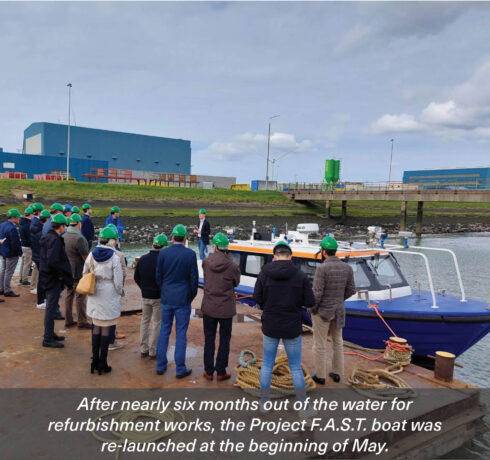The F.A.S.T.-boat for the autonomous sailing project is back in the water. The Midlife Update for HNLMS Johan de Witt is progressing steadily in Den Helder. At Vlissingen-Oost all sections of the hull construction project for Damen Yachting have been welded together. And exciting times are ahead for the Colombia project. You can read all about it in the updates below.
Busy times for a busy boat: F.A.S.T Project Update
After 25 weeks out of the water for refurbishment works at Vlissingen-Oost, the Project F.A.S.T. boat was re-launched at the beginning of May. The interior of the 1990-built Damen Stan Patrol 900 is now complete with comfortable seats for six people, air conditioning, heating, music, and a fridge. “And of course, the main focus is to involve public in this autonomous journey, so displays are added which allows to ‘see how the computer thinks’,” says Jochem Nonhebel, Project Leader of Damen Naval’s F.A.S.T. (Fieldlab Autonomous Sailing Technology) project. “We invited all the various partners and stakeholders to the re-launch – it is good to see so many people showing interest in our project.”
The F.A.S.T. project has two main ambitions. The primary goal is full autonomy: turning a crewed vessel into an unmanned vessel, “so that it can sail from A to B without a human at the helm”, Jochem explains. The second ambition is to convert this 30-year-old diesel-powered boat into a 100% zero emissions vessel, using electricity as the only power source. “Because we will be sailing mainly in harbour environments, the sustainability of this project is very important.”
 Working on the F.A.S.T. project: Electrical & Automation Engineer Pieter de Korte (left) and F.A.S.T. Project Leader Jochem Nonhebel.
Working on the F.A.S.T. project: Electrical & Automation Engineer Pieter de Korte (left) and F.A.S.T. Project Leader Jochem Nonhebel.
Jochem is happy to report that the project is making significant progress in both of these ambitions. “We will be starting with the first testing of the autonomous systems this summer, taking the boat out onto the Westerschelde. We are working closely with RH Marine – which has written the software which is going on board – and the University of Leuven – which has written a number of algorithms for this. RH Marine is an important supplier for this project; they have prior experience working on a smaller vessel at MARIN, and now they want to test it on more mature platforms like ours,” he says.
Regarding the second ambition, Damen Naval has signed a contract for the vessel’s new electrical propulsion system (it is currently still powered by its old diesel engines). “This contract with Praxis Automation includes the battery, electric motors and all associated equipment,” notes Jochem, “with our supplier committing to delivering the whole package in November. This will be is an important milestone for us.”
 The primary goal of the F.A.S.T. project is full autonomy: “so that it can sail from A to B without a human at the helm”.
The primary goal of the F.A.S.T. project is full autonomy: “so that it can sail from A to B without a human at the helm”.
Another extremely valuable role that the F.A.S.T. boat performs is public relations for the project, raising awareness and interest on the subject of autonomous shipping. To this end, the freshly-painted boat has been hard at work, with a PR schedule to rival that of a film star promoting their new film.
“We have been busy showcasing the subject of autonomous shipping – this helps to gain support for the project,” smiles Jochem. “Showing our boat and talking about the project at events such as the Ports Days in Vlissingen-Oost, the Liberation Day festival in the city of Vlissingen, the Harbour Days in Middelburg. In June we will be taking part in the ‘Mobility Day’ that is being organised by the Province of Zeeland. And then heading up to Noord Holland for SAIL Den Helder for some more demonstrations and ferrying VIPs for the Dutch Ministry of Defence.”
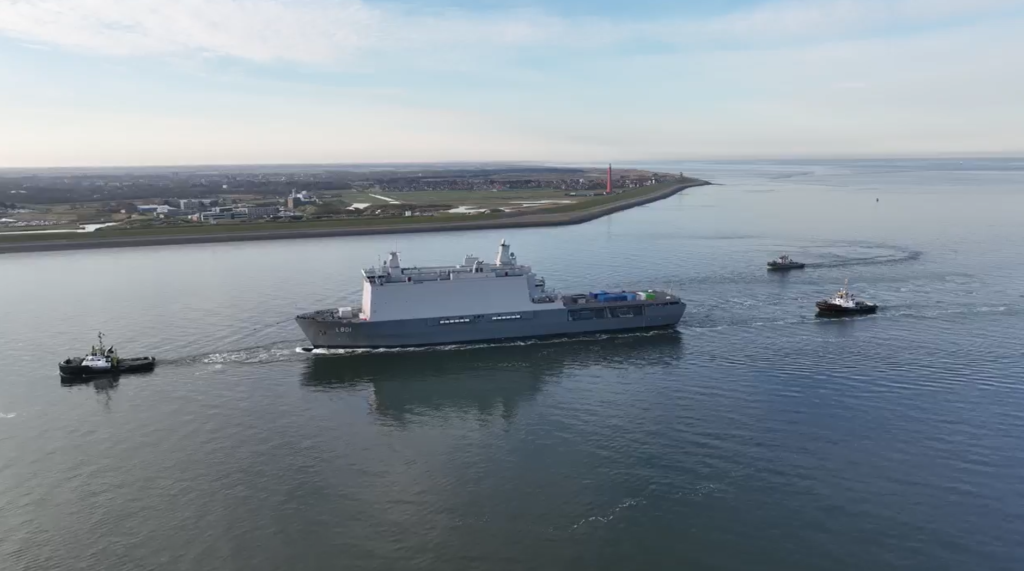 HNLMS Johan de Witt was towed into Den Helder in early April for the second part of the Midlife Update.
HNLMS Johan de Witt was towed into Den Helder in early April for the second part of the Midlife Update.
Finishing touches for Midlife Update HNLMS Johan de Witt
The end is in sight for the Midlife Update work on HNLMS Johan de Witt. The Landing Platform Dock has been in Den Helder since 4 April, where Damen Naval, together with the Materiel and IT Command (COMMIT) and the Dutch Naval Maintenance and Sustainment Agency (CZSK/DMI), are putting the finishing touches to the MLU. The work is a combination of additional work requested by the client and residual items from the Vlissingen part of the project.
“The work is going well and on schedule,” says Project Director Fer Tummers. “The coordination of the work is in our hands; we have a team in Den Helder led by our Production Project Manager Arend van Veelen and a number of foremen. We also work closely with Damen Shipyards Den Helder for much of the work and that is going very well.”
The remaining work now being carried out in Den Helder can be divided into three categories: residual items from previous inspections and reports, the completion and delivery of the accommodation and sickbay, and the replacement of the dry sprinkler and water mist systems. Fer: “Next week, we will have an internal project review with all members of the project team and sub-project leaders. I expect 80-90% of the remaining work to be completed by the end of June, and by the shutdown on 1 August, I expect to be completely finished. Then there will only be the sea trials in the autumn with which we will also be involved.”
The intention is for the Johan de Witt to be used as accommodation during Sail Den Helder and Marine Days. “There should be 140 guests on board. The accommodation is almost ready and the engine room has been delivered, but the finishing touches need to be made in terms of fire safety and drinking water supply. It will be exciting for a while yet, but the end is in sight,” Fer concludes.
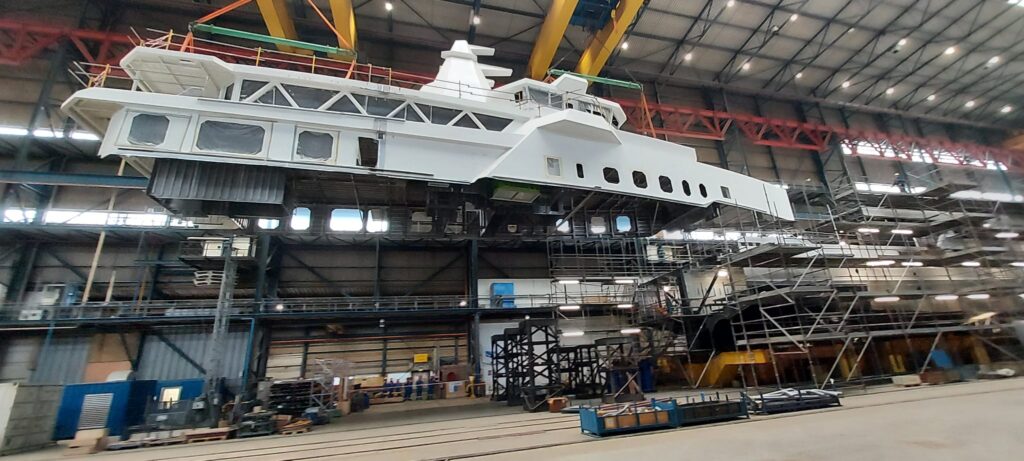 The aluminium superstructure was installed on the hull of YN 478 without major problems.
The aluminium superstructure was installed on the hull of YN 478 without major problems.
End of construction phase just around the corner for YN 478-project
Damen Naval’s hull construction project for Damen Yachting has continued to progress since the previous Schelde Schakels Project Update. “The aluminium superstructure has been installed on top of the hull and the final two sections have just come back from the painting shed,” begins the project’s Production Coordinator Stan Haag. “And in mid-June we will be handing over the first compartments to Damen Yachting. This is very positive; it means that our colleagues from Damen Yachting can come in with their suppliers and own people to get started with their work.”
Stan says that the project is “going in the right direction, but there is still a lot to do”. As such, the team at Vlissingen-Oost is working hard to complete the installation of technical ship systems like the rudders, anchor winches, crane installation, window frames and portholes. “Space on board is very limited,” adds Stan, “so we are focusing on planning our work scope – and more importantly, the order of work – very carefully.”
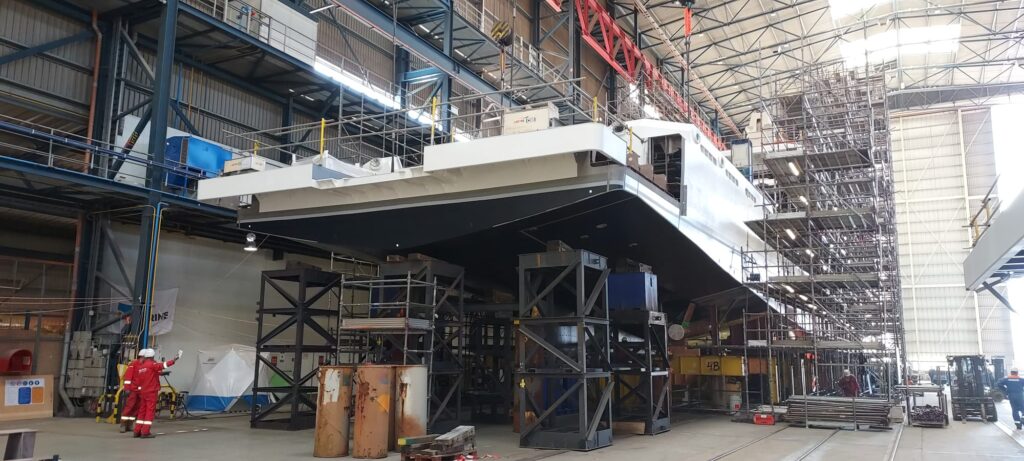 The rear two sections were placed against the ship in June.
The rear two sections were placed against the ship in June.
The coming month will see the installation of the vessel’s last two stern sections (marking the end of the construction and assembly phase of the project) and the completion of the central corridor. Do not be fooled by the term ‘corridor’: this is by no means a bare hallway running along the centre of the hull. “This is definitely not an empty space,” explains Stan. “It is a technical area full of piping, cables, ventilation shafts, hydraulic power unit, water systems, fuel manifolds – all sorts of equipment running from the engine room.”
With the construction and assembly phase complete, does this mean that the YN 478 will soon be moved to the water? “We want to keep it inside – out of the water – for as long as possible. Here in the hall, it is protected from the weather. Furthermore, it is level and stable, which means that our colleagues from Damen Yachting can do their work fitting out the interior accurately and to ‘superyacht’ levels of quality,” replies Stan. “We will move the vessel outside only when we need to start setting up and commissioning the ship systems.”
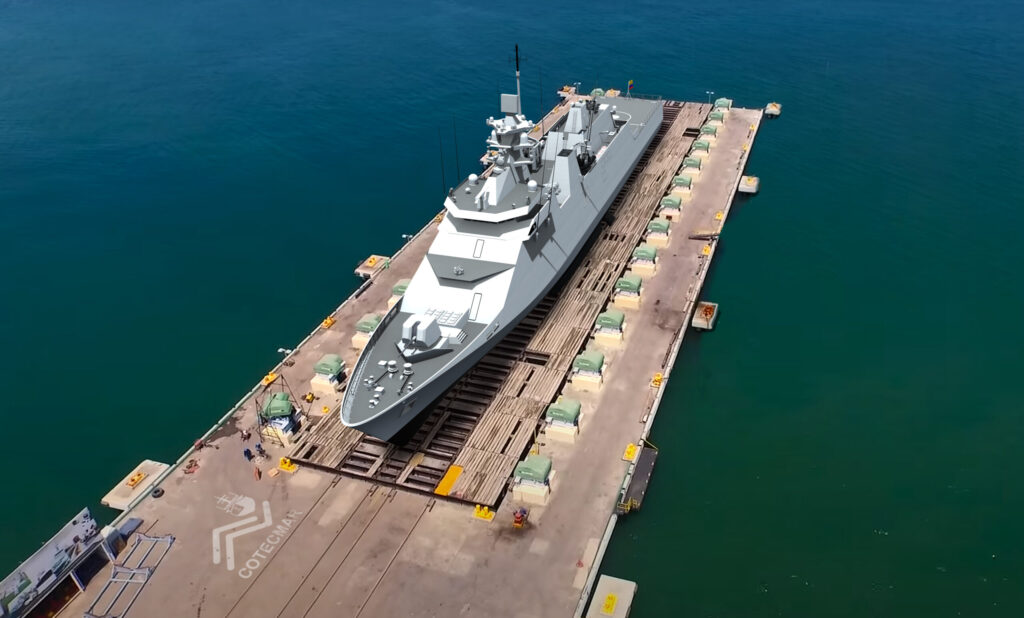 The Colombia project has entered a new phase: from design study to negotiating actual construction.
The Colombia project has entered a new phase: from design study to negotiating actual construction.
Design study COTECMAR is almost complete: where to from here?
The final package of design documents has been delivered to Colombian client COTECMAR. The project has thus entered a new phase: from design study to negotiating a contract for the actual construction of the frigate with the project name PES. “COTECMAR has a contract with the Colombian Ministry of Defence to build three ships, one of which will be our frigate,” explains Project Coordinator Simon Delva. “We are now negotiating the demarcation, the scope of the project and to what extent we will be involved.”
In September 2022, Damen Naval and Colombian shipyard COTECMAR signed a contract for a design study for the new generation of frigates to replace the ageing Padilla-class frigates. For the past eight months, the team has been working extremely hard to complete the Project Definition phase of the project thoroughly while meeting the required deadlines.
“It has been a very intensive period, during which a lot of work has been done in a short time by a relatively small team. Fortunately, it was short enough to be sustained,” Simon says. “There are still a few remaining points from the design contract that need to be crossed off, but we are now focusing mainly on the upcoming negotiations. That is a joint effort with input and support from lots of departments, such as Engineering, Procurement, Project Office, Proposals, Naval Sales Support, Sales in Gorinchem, Legal, Finance and more.”
As things stand, COTECMAR will do the detailed engineering itself, as well as the construction of the vessel, and the extent to which Damen Naval will be involved is now being assessed. “Besides the basic engineering drawings, we will also supply the materials for construction. Later this year, probably in the fourth quarter, we hope to conclude an agreement for this follow-up contract,” Simon concludes.

